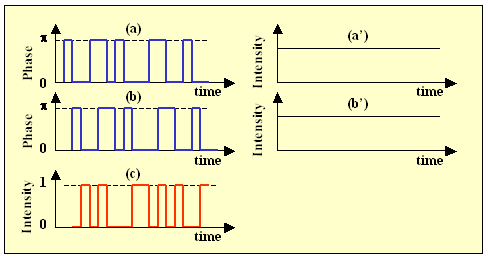
Optical DPSK demodulator
Encyclopedia
An Optical DPSK demodulator is a device that provides a method for converting an optical differential phase-shift keying (DPSK) signal to an intensity-keyed signal at the receiving end in fiber-optic communication
networks. It is also known as delay line interferometer
(DLI), or simply called DPSK demodulator .
 The DPSK decoding method is achieved by comparing the phase
The DPSK decoding method is achieved by comparing the phase
of two sequential bits. An incoming DPSK optical signal is first split into two beams with equal intensities, in which one beam is delayed in space by an optical path difference that introduces a time delay corresponding to one bit. The two beams in the two paths are then coherently recombined to interfere each other constructively or destructively. The interference intensity is measured and becomes the intensity-keyed signal. A typical optical system for such a purpose is Mach-Zehnder interferometer
or Michelson interferometer
, forming an optical DPSK Demodulator.
Delay time depends on the data rate
. For instance, in a 40 Gbit/s system, one bit corresponds to 25 picoseconds, and light travels 5 mm in a fiber optics or 7.5 mm in free space within that period. Thus the optical path difference between the two beams is 5 mm or 7.5 mm depending on the type of interferometer used.
DQPSK is the four-level version of DPSK. DQPSK transmits two bits for every symbol (bit combinations being 00, 01, 11 and 10) and has an additional advantage over conventional binary DPSK. DQPSK has a narrower optical spectrum, which tolerates more dispersion (both chromatic and polarization-mode), allows for stronger optical filtering, and enables closer channel spacing. As a result, DQPSK allows processing of 40 Gbit/s data-rate in a 50 GHz channel spacing system. A demodulator for optical DQPSK signals can be constructed using two matched DPSK demodulators with phase off-set at .
.
Fiber-optic communication
Fiber-optic communication is a method of transmitting information from one place to another by sending pulses of light through an optical fiber. The light forms an electromagnetic carrier wave that is modulated to carry information...
networks. It is also known as delay line interferometer
Delay line interferometer
A delay line interferometer can be a Mach-Zehnder interferometer or Michelson interferometer based on two-beam interference, in which one beam is time-delayed to the other by a desired interval....
(DLI), or simply called DPSK demodulator .

Phase (waves)
Phase in waves is the fraction of a wave cycle which has elapsed relative to an arbitrary point.-Formula:The phase of an oscillation or wave refers to a sinusoidal function such as the following:...
of two sequential bits. An incoming DPSK optical signal is first split into two beams with equal intensities, in which one beam is delayed in space by an optical path difference that introduces a time delay corresponding to one bit. The two beams in the two paths are then coherently recombined to interfere each other constructively or destructively. The interference intensity is measured and becomes the intensity-keyed signal. A typical optical system for such a purpose is Mach-Zehnder interferometer
Mach-Zehnder interferometer
The Mach–Zehnder interferometer is a device used to determine the relative phase shift between two collimated beams from a coherent light source. The interferometer has been used, amongst other things, to measure small phase shifts in one of the two beams caused by a small sample or the change in...
or Michelson interferometer
Michelson interferometer
The Michelson interferometer is the most common configuration for optical interferometry and was invented by Albert Abraham Michelson. An interference pattern is produced by splitting a beam of light into two paths, bouncing the beams back and recombining them...
, forming an optical DPSK Demodulator.
Delay time depends on the data rate
Bit rate
In telecommunications and computing, bit rate is the number of bits that are conveyed or processed per unit of time....
. For instance, in a 40 Gbit/s system, one bit corresponds to 25 picoseconds, and light travels 5 mm in a fiber optics or 7.5 mm in free space within that period. Thus the optical path difference between the two beams is 5 mm or 7.5 mm depending on the type of interferometer used.
DQPSK is the four-level version of DPSK. DQPSK transmits two bits for every symbol (bit combinations being 00, 01, 11 and 10) and has an additional advantage over conventional binary DPSK. DQPSK has a narrower optical spectrum, which tolerates more dispersion (both chromatic and polarization-mode), allows for stronger optical filtering, and enables closer channel spacing. As a result, DQPSK allows processing of 40 Gbit/s data-rate in a 50 GHz channel spacing system. A demodulator for optical DQPSK signals can be constructed using two matched DPSK demodulators with phase off-set at
 .
.

